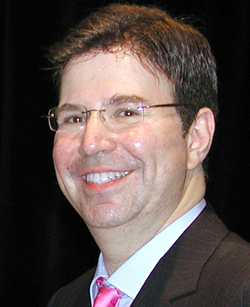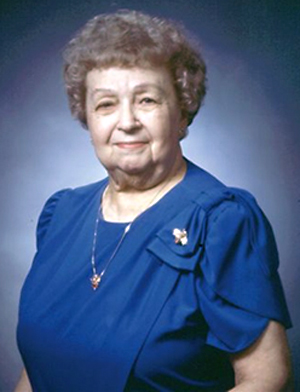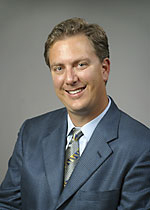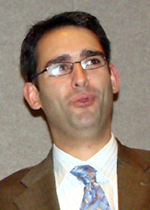Planting the Coin-Collecting Seeds
By Leon Worden
August 2006
| D |
Scott A. Travers is no stranger to COINage readers. For more than two decades, Travers, 44, has taught both novice and advanced collectors how to make money in coins and avoid getting scammed. Currently published by an imprint of Random House, his popular titles, such as "The Coin Collector’s Survival Manual" and "One-Minute Coin Expert," are inspiring investors and protecting consumers at bookstores everywhere.
John J. Kraljevich Jr. might not be a household name yet, but give him time. Only 28, Kraljevich is the director of numismatic research for American Numismatic Rarities LLC, a major coin auction house in New Hampshire. Working alongside the modern dean of numismatics, ANR’s Q. David Bowers, Kraljevich has carved a niche as one of the leading experts in colonial and early U.S. coinage.
Manley, Travers and Kraljevich represent three distinct corners of numismatics: big-league investor, consumer advocate, researcher. They’re among the best at what they do.
|
"I was already an avid coin collector, but it was getting involved in the ANA’s YN program [at age 15] that really launched things to a whole different level," said Manley.
According to U.S. Rep. Howard "Buck" McKeon, chairman of the House Committee on Education and the Workforce, people who go to college can expect to earn $1 million more throughout their lifetimes than those who don’t.
Manley earned his first $1 million in coins at age 23. Today he is worth many multiples of that. He never went to college. But he did attend the ANA’s Summer Seminar at the Colorado College campus in Colorado Springs.
"The ANA doesn’t make the person. It doesn’t make you successful. But it gives you opportunity," Manley said. "It gave me an opportunity to interact and meet the best and greatest minds in numismatics."
The roots of the modern YN programs can be traced to the mid-1960s when the coin hobby was riding high. The Mint had withdrawn silver from most circulating coinage, and the hunt was on. Americans young and old who had never previously collected were rifling their pocket change for treasure.
Seeking to capitalize on the phenomenon and give those budding numismatists a place to go, the ANA lowered its age limit in 1966 from 17 to 11. National Coin Week chairmen Rich and Virginia Bronson launched competitions for the "junior" members; veteran California dealer Abe Kosoff and others awarded scholarships for writing and exhibits.
One of the early "juniors" was (today) COINage Contributing Editor David Ganz, who joined in 1967 at age 16. Appointed to ANA’s new YN Committee, he appealed to ANA President Herb Bergen and Executive Director Adna G. Wilde Jr. to launch a new publication geared toward the young collector. With funding from Kosoff’s Professional Numismatists Guild, "The Young Numismatist" was born; Ganz edited the quarterly journal from 1969-74. (Ganz would later serve as PNG attorney and ANA president.)
But 1969 was a watershed year for another reason. In the ANA’s main journal, The Numismatist, Editor Ed Rochette invited readers to come to Colorado Springs for a week-long seminar titled, "Numismatics in General, A Basic Introduction to Coin Collecting," with trips to the Denver Mint and the Cripple Creek gold district.
It was a smashing success, and it developed through the years into the best crash course in numismatics: The ANA Summer Seminar.
In 2006, approximately 500 "students" young and old were expected to sign up for hands-on training in July from some the biggest names in a variety of numismatic specialties. That’s better than a 20-fold increase in enrollment since 1969.
"Adna Wilde ... and I started the Summer Seminars," Rochette remembered. "[Colorado] College gave us one classroom and then we had a different instructor each day."
"There were adults and there were kids, and it was kind of a nice thing," he said. "We drove all the students around in [Wilde’s] car and my car. We took them to a coin club meeting and things like that."
He remembers one student in particular from those early days: A grandson or grand nephew of Kosoff.
"He was there the first day, and toward the end of the day when we were taking head count, he’s gone," Rochette said. "He had checked out of the school. Gave them some excuse that he had to get back home. He got to the airport, got his ticket transferred, and was on the plane [by the time] we knew about it. I called his parents and they said, ‘It wasn’t what he thought it was. There’s no horseback riding there.’"
|
The solution came in the person of Florence M. Schook.
Florence Schook hailed from Lavonia, Michigan, where she was a key figure in the Central States Numismatic Society and the Michigan State Numismatic Society. In 1973 she was named the ANA’s "Outstanding Adult Advisor to Young Numismatists" and in 1974 was appointed chief administrator of the Young Numismatists Correspondence Course, a popular writing program that gave young collectors a forum for sharing their knowledge. By the mid-1970s she was running the Summer Seminars, as well.
"She’s the one who worked so hard to get the funding for Summer Seminar scholarships for kids," said Gail Baker, the ANA’s education director from 1999-2005. "I would certainly give Florence Schook a lot of the credit" for the seminars’ success.
Schook made it possible for kids to attend by wrestling donations from dealers and hobby leaders. In 1976 she facilitated a giant scholarship from The Franklin Mint (at the time, a major and well respected private mint) that sent 43 youngsters, ages 12-17, to the Summer Seminars. Scholarship contestants had to write an essay on "Why I Am a Collector." Rochette was the judge. The goal was to select one winner from each state; they came close. Another 11 YNs won separate ANA scholarships.
The majority of youngsters signed up for Lincoln Cent specialist Sol Taylor’s class on coin grading. Runner-up in youth enrollment was a general course on collecting taught by Rochette, followed by Ken Bressett’s class on colonial coins. Most popular with the 70 adults who paid their own way was a class on detecting counterfeit and altered coins, taught by specialists from ANACS, the coin authentication service then operated by the ANA.
The year 1976 also saw suffrage for YNs: They could now vote in ANA elections. By the mid-80s, the age limit was lifted all together; anyone can join and vote today. "In fact, we have had certain [ANA board members] sign up ‘to-be’ children, while they were still in utero," said Baker.
Beyond the scholarship money, Schook is remembered for taking young collectors under her wing and making them comfortable.
"She kind of adopted the kids," Rochette said. "At the conventions and during the Summer Seminars, she came in and was a mother to them."
One kid she "adopted" was Scott Travers, who joined ANA and became a professional coin dealer in 1976 at age 13. He won a Summer Seminar scholarship the following year.
"Florence’s programs were predicated on motivational participatory education," Travers said. "Give a young person coins, free books, camaraderie, and by giving things away, it promotes an interest in coins that a youngster will pursue on his or her own."
In Travers’ case, it evolved into a lifelong career. If not for the ANA’s YN programs, "I’d probably be a doctor," said Travers, who graduated from Brandeis University in 1983 with a bachelor’s degree in politics and wrote most of his first book, the Survival Manual, while still in college.
"I entered Brandeis as a premed student. Then I later changed to pre-law and deferred my admission to law school so I could deal in coins," he said. "My first book was published by an imprint of Prentiss Hall and I never went back."
Outstanding Young Numismatist of the Year in 1978, Travers served as first vice president of the ANA from 1997-99.
By 1981, interest in the Summer Seminars had grown to the point where the ANA experimented with holding them in two locations: one week at Pennsylvania State University, and the following week in Colorado Springs. Dwight Manley attended the session in Colorado.
|
"I found other people with a passion for coins, and that was like nirvana. You couldn’t have anything better than that. All of these kids were from around the country. None of us really knew people like ourselves."
"Mike Fuljenz [then of ANACS] was one of the teachers," Manley remembered. "David Bowers was my first instructor for ‘All About Coins.’ He was my idol from before going there. Mrs. Schook was like the mother hen figure and made sure everybody was taken care of. Ed Rochette, Nancy Green at the library; it was a very familial group."
In 1982 Manley worked as a page at the ANA convention in Boston. "I wore a red vest and I used to get [current Heritage Auctions co-chairman] Steve Ivy hot dogs or [Beverly Hills coin dealer] Kevin Lipton a soda, and whether I got 50 cents or a dollar, it didn’t matter because we just wanted to be a part of the numismatic world. The ANA enabled that."
While still in high school Manley worked at a coin shop in Fullerton, Calif., and he showed auction lots for Bowers and Merena during the summer. After graduation he dealt in coins full-time.
"The thing that really got me appreciating coins, and what I loved about it from a business standpoint, was the pre-slabbing or certification, when it was truly your own knowledge that you used against somebody else when you were trading coins," he said. "When things changed, it took away a lot of that romance."
By that time, his friend Dennis Rodman was "kind of floundering, personally" and asked for Manley’s assistance. From 1995-99 Manley focused on pro sports; then in 2000 he had "a childhood fantasy come true" when he was able to purchase what Life magazine called "the greatest treasure ever found." He also managed to pick up some smaller items, including two of the five 1913 Liberty Head nickels.
"If the ANA didn’t exist and open doors for me, my numismatics might be limited to working at the local coin shop, owning the local coin shop, or being on a much more localized level," he said.
Manley returned the favor at the ANA’s 2002 convention in New York with a $250,000 check. The ANA library now bears his name.
During the August 2006 convention in Denver, Manley hopes to establish an endowment in Schook’s name to fund Summer Seminar scholarships.
Schook, the ANA’s president from 1985-87, died April 2, 2006. She was 88.
Gail Baker took a peculiar route to the ANA where, as manger of market and brand development, she is a senior staff member. She discovered the ANA in while playing chauffer to her coin-collecting kid — John Kraljevich.
"We’re sort of the inverse of the usual parent-child relationship in coins," said Kraljevich. "She drove me to the Pittsburgh ANA show ... and brought the Lee Iacocca autobiography with her to sit by the pool and read the whole week. That has become sort of a favorite object in the family. To this day, the covers have never been cracked.
|
By the time Kraljevich joined ANA in 1988 at age 10, "The Young Numismatist" was long gone; in its place was "First Strike" magazine.
"It gave young writers the hope that if they wrote something, they could actually get it printed in a national magazine," said Kraljevich, now a regular contributor to the ANA’s primary publication.
"There were educational forums and the YN auction, and I worked as a page," he remembered. "The dealers, instead of tipping with cash, would let me pick from their junk box [of low-value coins]. There were YN tours; we could sort of get to know each other socially. There were a lot of fun things to do back then."
Kraljevich, who double-majored in history and religious studies at the University of Virginia, also was active with the Young Numismatists of America (YNA), a separate organization that has come and gone many times since 1962. It has tended to start up whenever a particularly dedicated crop of young ANA Summer Seminar students wanted to keep the momentum going throughout the year, only to dwindle when the leaders have gone off to college.
In its current form, YNA has been going strong since the late 1990s and has about 95 members, mostly under age 22, said newsletter editor Cameron Kiefer, who attended his first Summer Seminar in 2000 as a YN and is now an instructor.
"ANA doesn’t have many places for YNs to publish articles. That’s the main focus of the club," said Kiefer, a professional grader with Independent Coin Grading (ICG) of Englewood, Colorado. "Some of these kids will blow you out of the water with how they research [numismatic topics]. It’s amazing."
YNA’s quarterly newsletter, coincidentally named "The Young Numismatist," is 17 pages and growing, Kiefer said. Online at ynaclub.org, the group hopes to fund a scholarship to ANA’s Summer Seminar next year.
Kraljevich, a 1990 and 1991 Summer Seminar graduate, was scheduled to teach about colonial coins at this year’s Summer Seminar. He’d like to see more publishing opportunities for youngsters, as well. "Certainly First Strike was there, and now it’s not, and I think that was a really important thing. But there are still a lot of great things [at ANA] for YNs."
Topping the list is the Summer Seminar, but there are writing and exhibition award competitions for young enthusiasts, as well. The David R. Cervin Ancient Coin Project, sponsored by Chicago dealer Harlan J. Berk, invites youngsters to "grow from being a coin collector to a numismatist" by writing school reports or making presentations about coins or paper money at clubs meetings or other gathering places. Projects needn’t be about ancient coins.
Similarly, the Early American Copper Coin Project, sponsored by Douglas F. Bird of Hermosa Beach, California, offers rewards for youngsters 22 and under who write about coins, exhibit coins or participate in Summer Seminar courses.
There are YN auctions for teenagers and "Treasure Trivia" games for younger kids at ANA-sponsored events. There are internship opportunities in Colorado Springs. On the horizon is an expanded effort to help Boy Scouts earn their Coin Collecting merit badge and Girl Scouts earn their Fun With Money patch.
Baker is particularly proud of her "Coins in the Classroom" program. "The emphasis is on training the trainers, taking it up a step and working with teachers who may have hundreds and hundreds of students."
ANA tries to provide programs that will pique the interest of a variety of ages and skill levels, she said.
"We’ve got young people who are interested in the hobby, interested in numismatics, and they’re usually very bright and often do better in the [Summer Seminar] classes than the adults do. Then there are young people who come to our conventions who are not at that stage yet. We have completely different programs for these two groups of young people."
"There are lots of ways to plant the seeds. With the Treasure Trivia game, we try to put something in their hand, a little bit of knowledge, a Buffalo nickel, an Indian Head cent, hoping it will be the little seed to really start them on their collecting interest. But the kids who already have a strong interest — the kids who come to the Summer Seminar and are just a sponge for numismatic information — definitely hold their own with the adults. It’s just a fabulous, fabulous group of kids."
"Coins are the absolute pathway to history and culture and art and science," Baker said. "We find that we can teach anything at all through the prism of money."
©2006, MILLER MAGAZINES INC./LEON WORDEN. RIGHTS RESERVED.





